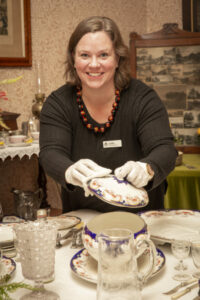
Lexie Palmer-Gapper brings extensive international experience and a desire to ensure her team members are happy and fulfilled to her latest role.
Originally from the United States, Palmer-Gapper took over as Howick Historical Village’s new general manager late last year.
Before moving to New Zealand she and her husband were living in the State of Washington.
Her prior role was a four-year stint as director of the Cashmere Museum and Pioneer Village, named for the city it’s located in.
Palmer-Gapper says her husband, who’s a Kiwi, lost his job in the plant science industry at the start of the Covid-19 pandemic.
He was offered a new position in Auckland and the couple decided to move to New Zealand.
Palmer-Gapper says her background is in art history and she’s held numerous positions in the arts and museum sector.
They include roles at the prestigious Whitney Museum of American Art, Sotheby’s, and the Herbert F Johnson Museum of Art at Cornell University.
“The one thing that connects all of my work experience has been collections, archives and handling and researching objects,” Palmer-Gapper says.
“All of those things together created a situation and a set of skills that prepared me to lead the Cashmere Museum and then move here.”
Palmer-Gapper says her work as general manager is being guided by the historical village’s 2021-2024 strategic plan.
She’s focusing on three main areas, being the staff, its collections, and education programmes.
“I care very deeply about the staff and their success and happiness.
“I want to make sure they stay, they’re fulfilled and to limit turnover.
“That’s a very big thing for me.”
She says every member of her staff is outstanding in their role and the village’s board president Marin Burgess has been “incredibly helpful”.
Palmer-Gapper is particularly grateful for the institutional knowledge of those who are not new to the team, including heritage gardener Luke Southern, marketing and social media co-ordinator Annaliese Lines, educators Kate Hallam, Sarah Cartwright, Ellen Holliss, Richard Giles, and Kathy O’Connor, and facilities manager Phil Sutton.
“Luke has been here for about three years and he’s done a magnificent job with the gardens.
“He has a very special approach and wants them to look like what village life would have looked like in the 1840s, so things aren’t going to be manicured.
“He’s creating a living museum, a living space, for these buildings to sit in and feel at home.”
She says taking care of the village’s collections is also a top priority.
That includes its buildings and “all the items in the buildings and making sure they’re cleaned properly with proper conservation tools and materials and solutions and methods”.
“I want to make sure things can be viewed to their best advantage and stay in their best shape for the next 100 years.”
Her third area of focus is to restructure the village’s education programmes.
“We have a fantastic new education manager in Rosie Grant and have great educators who stayed with us from the previous general manager,” she says.
“They have insightful, engaging programmes with the kids and I’m hoping we can expand those to be more inclusive of Auckland in 1840-1880 and not just [focus on] the Fencibles.
“We want to contextualise why we’re here and what we’re responding to with this space.”








